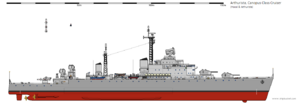Canopus-class cruiser
 HHS Castor
| |
| Class overview | |
|---|---|
| Name: | Canopus Class Cruiser |
| Builders: | Vickers Arthurista |
| Operators: | Commonwealth Navy |
| Preceded by: | Minotaur-class cruiser (1943) |
| Succeeded by: | Phobos-class destroyer Batch 2 |
| Completed: | 4 |
| Active: | 0 |
| General characteristics | |
| Type: | Cruiser |
| Displacement: | 17,725 tonnes |
| Length: | 197m |
| Beam: | 24.07m |
| Draught: | 7m |
| Propulsion: | 4x three-drum boilers, 4-shaft steam turbines, 120,000shp |
| Speed: | 32kn+ |
| Sensors and processing systems: |
list error: <br /> list (help)
|
| Armament: |
list error: <br /> list (help)
|
The Canopus-class was an Arthuristan guided-missile cruiser design. Three ships of the class were built and they served from 1958 until their retirement in 1987.
Design
The Canopus was a direct descendant of the Commonwealth Navy's cruisers which saw action in the 1940's. Years of hard use and abuse had worn down the fleet's major units. As such, in the late-1940's the Admiralty began to consider their replacement by a single, multi-function class. Unfortunately, major disputes arose as to the ships' design direction.
The Bureau of Construction believed that the prime role of the cruiser is that of a heavy anti-air escort, to provide protection for carrier battle groups and fast convoys. The Dido-class cruiser was the archetype they were aiming to emulate. Captains, however, emphasised the cruisers' independent patrol and cruising role. In light of the retirement of most of the navy's fleet of capital ships, the cruisers' sea dominance role has become vital. Their vision was to construct something similar to the Town-class cruiser, with its formidable anti-surface firepower.
Technology provided this seemingly intractable problem with a solution in the form of the QF 6 inch Mark N5 gun. This is a water-cooled, automatic weapon capable of firing up to 20 rounds per minute, a rate of fire which, in theory, could exhaust the ship's magazine after 20 minutes of sustained firing. This rate of fire was deemed capable of engaging fast-moving aircraft with radar-directed gunnery, whereas in the anti-surface role it would smother an enemy ship with such a volume of fire that it would quickly set its superstructure aflame and render its hors de combat. Three such turrets were included in the design, supported by 40mm small-calibre anti-air guns.
However, in the 1950's at the dawn of the missile age, the Admiralty decided to use the large hulls of these cruisers in order to test the integration of guided weapons onto surface warships. Designs such as the indigenous Sea Slug and the imported RIM-8 Talos were tested on a number of old ships. In the end, the latter's great range won over the Admiralty, and it was decided that a Talos launcher, plus a 40-rounds magazine, would replace Y-turret. Two of the twin-40mm rounds were also replaced by the Seacat missile in the 1960's, although this was viewed by many as the replacement of an old and trusted system by a substantially less-valuable one. They were replaced by a pair of {{Wp|Phalanx CIWS} in the 1980's. In addition, eight ACM-2 Renove were added in a pair of quadruple amidships mounts in the early-80's.
As a result of this spiralling 'inflation' of the vessels' capability, the final design was so costly that only four Canopus cruisers were ever built. Of the four, HHS Canopus itself was mothballed within eight years of induction into service and later used as spare parts to maintain the remainder of the class. The remaining three were converted into guided missile cruisers as described above. These were assigned as escorts to the navy's heavy fleet carriers.
Operational history
The Canopus soon proved to be a formidable anti-air platform. At the time, the Admiralty anticipated that enemy air attacks would come in two forms- high diving heavy supersonic missiles, launched from heavy bombers, and low-level bomb attack by wave-skimming fighter bombers. With its combination of Talos and automatic guns, the Canopus was in a position to deal with both effectively. The Talos's 180km reach allowed the ship to project a formidable air defence bubble around the carrier battle group.
At the same time, however, not all systems worked perfectly. the automatic 6-inch turrets were heavy, complex and a maintenance nightmare and difficult to keep operational. By 1967, it was decided that only one turret in two would be routinely operated in peacetime in order to reduce repair and maintenance requirements. The Admiralty considered their replacement with 6-inch turrets taken from scrapped cruisers, but left them in place due to their indisputable utility in both the anti-air and -surface roles.
By the 1980's the ships still carried the Commonwealth Navy's most long-ranged anti-air system. It would not be until Sea Dart received its Mod 2 upgrade did it gain something close to parity with the Talos's range. Nevertheless, the Talos was increasingly problematic, especially in dealing with multiple targets. With the Interim Advanced Air Defence variant of the Phobos-class destroyer gradually coming online, the retention of the Canopus, a costly and obsolete platform, became untenable. The ships were fully retired by the end of 1992.